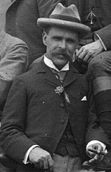Robert T. Hill
| Robert Thomas Hill | |
|---|---|

Hill in 1897
|
|
| Born |
August 11, 1858 Nashville, Tennessee, U.S. |
| Died | July 20, 1941 (aged 82) Dallas, Texas, U.S. |
| Citizenship | American |
| Fields | Geology, Stratigraphy |
| Alma mater | Cornell University |
| Known for | Geology of Texas |
Robert Thomas Hill (August 11, 1858 – July 20, 1941) was a significant figure in the development of American geology during the late nineteenth century and in the early part of the twentieth century. As a pioneer Texas geologist, Hill discovered and named the Comanche Series of the Lower Cretaceous, and was a lifelong student of the structure and stratigraphy of the Cretaceous deposits of Central Texas and neighboring regions.
Robert T. Hill was born on 11 August 1858 in Nashville, Tennessee. He was orphaned at the age of five during the American Civil War and then raised in the home of his grandmother. In 1874, at the age of 16, Hill boarded a train and traveled to where the tracks ended in east Waco, Texas. From there he found his way to the frontier town of Comanche, Texas, located 89 mi (143 km) to the west of Waco where he joined his brother, Joe, the editor of The Comanche Chief newspaper. Robert worked as a printer for the newspaper and performed various other duties including writing, bookbinding, and eventually became co-editor of the paper.
During the summer of 1876, Hill joined a survey crew headed to the rolling plains between the eastern edge of the Llano Estacado and Fort Griffin, Texas. The work, although somewhat tedious at times, provided an opportunity for Hill to explore the “redbed country” of west-central Texas. This land of reddish brown sediments and rock has been carved by years of erosion leaving behind scenic mesas and buttes that preserve clues to the regions geologic past. In 1877, at the age of 19, Hill accepted an offer to work as a cowboy driving a large herd of cattle from Uvalde, Texas, to Dodge City, Kansas. The cattle drive took many months, during which time he learned to live outdoors for extended periods and developed frontier skills that would prove valuable in later years as he worked as a field geologist.
Returning to work again at The Comanche Chief newspaper, Hill began to spend idle time exploring the local terrain. His interest in geology grew as he took special interest in the many flat-topped mesas and buttes in the region. One butte in particular, named Round Mountain, was located only 6 mi (9.7 km) to the northwest of Comanche and he often climbed to the top to enjoy the view. Although he had little knowledge of geology at this point, he found the fossils along its rocky slopes to be fascinating and he began to collect specimens. Hill’s collection of fossils grew and soon cluttered the windowsills and filled the corners of the newspaper office.
...
Wikipedia
